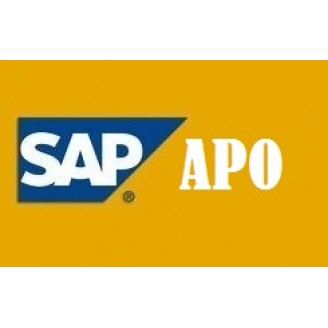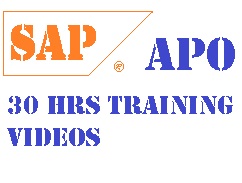SAP APO VIDEO TRAINING @ $ 99
Reward Points: 0
Availability: In Stock
KEY FEATURES :-
- 30 Hours real online recorded videos training.
- Supported documents.
- High Level training videos for fresher and experience students.
- Permanent videos for download and learn at your convenient time.
SAP APO Sample video available here
Overview of the Advanced Planner and Optimizer
The Demand Planning (DP) component of SAP Advanced Planner and Optimizer (SAP APO) is a complex, high-performance, and flexible instrument that supports the sales/requirements planning process in your company. User-specific planning layouts and interactive planning books allow not only the inclusion of various departments, but also of other companies, in the forecast creation process.
The configuration of demand planning is an important factor for a successful implementation of the system. This is performed, as it is also done for the Supply Network Planning component (see Chapter 5, Inventory Planning with SAP APO-SNP—Basic Principles), with the Supply and Demand Planning (S&DP) Administration Workbench.
The entire administration of the demand planning component and the components required for configuring the planning area are summarized in Figure 3.1.
First, we will give you a brief overview of the terms detailed in the figure and their relationships; then, they will be described in greater detail in the following sections.
- Before you can begin the planning process, you must decide what key figures you want to use for demand planning. Key figures contain data that is shown as a numeric value—either a quantity or a monetary value. Examples of key figures that are used in demand planning are planned demand and historical sales. You can save key figures both in an InfoCube and in the liveCache. You usually save key figures with historical data, that is, actual key figures, in the InfoCube. You save planning key figures in the liveCache. You also save those planning key figures that are to be firmed (i.e., fixed) in the InfoCube.
- You must then decide what characteristics you want to use as planning levels and for selection. A characteristic is a planning object such as a product, location, brand, or region. The master data of the demand planning or the supply network planning comprise the allowed values of the characteristics, known as the characteristic values. Characteristic values are actual names. For example, the characteristic "Location" can have the values Hamburg, London, and New York. As part of the administration for Demand Planning (DP) and the Supply Network Planning (short description: S&DP Administration), you create a basic planning object structure for the characteristics that you want to use. A basic planning object structure contains all plannable characteristics for one or more planning areas. It is the structure on which all other planning object structures are based. The characteristics can be standard characteristics or those that you have created in the Administrator Workbench.
- Once you have determined the key figures and characteristics, you must store additional information in the planning area. This includes, for example, the storage buckets profile, in which you determine the periods in which data is saved for a given planning area in the Demand Planning or in the Supply Network Planning; or the planning versions, in which different datasets can be saved for simulation purposes. Furthermore, you must ensure that the base unit of measure and the basic currency are assigned for the planning area.
- You have defined the planning area when this information is assigned to the planning area.
- You can then create individual user or department planning books. Planning books determine the content and layout of the interactive planning screen. You can use them to design the planning screen so that it corresponds to your planning requirements. A planning folder is based on a planning area.
- Finally, you create the master data for Demand Planning (this cannot be seen in Figure 3.1). The master data of the Demand Planning determines the levels on which demand plans in your company are created, changed, aggregated, and disaggregated. For instance, your master data can comprise all products, product families, regions, and customers that are to be planned in your company with the APO Demand Planning, as well as all corresponding combinations of these (e.g., which customers buy what products in which regions). Once you have created the master data, the implementation of the Demand Planning can begin.
Why i should register to SapTopDocs?
SapTopDocs SAP Centre has got proven record of providing self learning solutions across the globe for more than 20 Countries having about more than 5000 happy customers globally.
- More than 5000 happy customers from more than 70 countries
- Self Learning Video's were done by the certified and experience professionals
- Easy to follow training video's .
- Continuous support through our portal with all the necessary inputs like interview questions, latest trends in the SAP Sector, Job Opportunities etc.,
- 24x7 Support if you have any issues accessing your training video's.
- We do have almost require SAP documents which include baseline configuration , post coniguration , training videos , implementation etc.
Frequently Asked Question's to SapTopDocs:
Q ) How to Enroll with this Course ?
A) You can just send us an email for the sample video's and we would send you couple of video's for your reference and you can book your course using the payment options like PAYPAL.
Q ) Do i get the access to the SAP Environment for the practice ?
A) Yes, For SAP Remote Access register to www.idesremote.com with additional charges and you can access to the SAP Environment for 24x7 .
Below topics are cover in syllabus
SAP APO Overview and Function of Planning Application
- · Concepts of Supply Chain Management
- · List the Advantages of APO
- · Summarize the functions of the planning applications in APO
- · Integration and Technology (Live Cache, Integration with OLTP system using CIF)
- · Modeling and Evaluation in APO (Overview of Master Data and Transaction data for
- Supply chain planning, Function of Model and Version)
- · Overview of master data and Transaction data in APO
Internal SAP SCM APO Business Warehouse
- · Purpose of Internal Business warehouse and concept of extraction of transactional data
- · Role and Function of Data warehousing workbench and Components
- · Structure of Characteristics and Key Figures
- · Overview of data source and data extraction
- · Process of configuring LIS for data structure
- · Info source, Info packages and Info cube in detail
Set up Demand and Supply planning in SCM APO-Configuration of DP
and SNP
- · Creating Planning Object Structure
- · Planning levels of demand planning in POS
- · Task of planning object structure, master data and characteristics values combinations
- · Creation of Characteristics values combinations
- · Create planning area and Planning Book with data view
- · Set aggregation and disaggregation for key figures
- · Create time series in live cache
- · Key figures setting in planning area
- · Describe aggregation and disaggregation methods
- · Calculate proportional factors
- · Planning Object structure
- · Planning area
- · Planning Book and Data view
- · Macro and Alerts
Apply Demand Planning DP for forecasting
- · Demand Integrative planning Table and additional features in DP
- · Forecasting Process (Univariant Forecast,MLR,composite ,consensus planning)
- · Generation of proportional factor in DP
- · Life Cycle planning (Realignment, Life cycle planning and Product interchangeability
- · Advance Macros in DP
- · Promotion Planning
- · Mass Processing
- · Process chain in DP
Integration between SAP APO and ECC systems using CIF
- · Architecture of the integration of the system SAP ECC with the system SAP SCM:
- Logical systems, target systems, queued RFC, RFC-destinations, business system group
- · Generation of integration models for the core interface (selection of master and transaction data which should be transferred)
- · Activation of integration models (transfer of the selected data)
- · Initial and change transfer of fundamental master data from the SAP ECC (e.g. Plant, distribution center, material)
- · Real-time transfer of transaction data (stocks, orders) from SAP ECC as well as retransfer of transaction data like planning results from SAP SCM to SAP ECC
- · Reports for routine operation
- · Monitoring and treatment of errors during the transmission (CIF cockpit, SCM queue manager, qRFC monitor, application log, and so on)
Apply supply network planning (SNP) for cross location planning
- · SNP Overview, SNP Process flow.
- · Master data and Transaction data in SNP
- · Supply Network Planning Methods (Heuristic, optimizer and CTM)
- · Supply Network Planning Heuristic (Heuristic Run, Capacity Check and Leveling)
- · SNP Heuristic scheduling
- · Aggregated Planning
- · Optimization in SNP (Supply planning with Optimizer, Optimizer costs, profile used by optimizer)
- · Product interchangeability
- · Safety stock Planning in SNP
- · Basic of Deployment and TLB
Capable to Match (CTM) in SCM
- · Functionality of CTM
- · CTM master data selection
- · CTM planning process types
- · System landscape required for CTM
- · CTM demand and supply processing
- · CTM planning algorithm
- · Supply control with CTM
Set up Production Planning and Detailed Scheduling in SAP SCM
- · Maintain Number ranges for orders
- · Maintain Strategy Profiles
- · Maintain Planning Procedures and Planning Groups
- · Set up times
- · Maintain PPDS Heuristic setting and Profiles
- · Maintain work area
- · Maintain Period board profile and Time profiles
- · Set up management and alert monitor
- · Set up propagation ranges
Apply Production Planning and Detailed Scheduling for planning of orders
- · Role of PPDS in SCM
- · Master Data overview
- · Demand Management (PIR and sales orders,MTS & MTO)
- · Production planning (Prerequisite and Setting,Planning Process,Heuristic for MRP planning and Firming)
- · Steps in PP (Net requirement calculation and lot size calculation,Source determination,PPM/PDS explosion,Set up times ,Pegging)
- · Tools and Production planning (Product view,Product planing table,Pegging overview,Days
- supply,Detailed scheduling board,Resource planing table,PPDS optimizer and Alert monitor)
Set Up Global Available to Promise
- · Maintain Global Setting for Available check
- · Maintain Category,Check mode and Check instruction
- · Maintain ATP group and check control
- · Maintain Allocation object ,group and Procedure
- · Sequence of product allocation procedure
- · Maintain Rule strategy and sequence for rule-based available check
- · Parallelizing backorder processing

Write a review
Your Name:Your Review: Note: HTML is not translated!
Rating: Bad Good
Enter the code in the box below:






